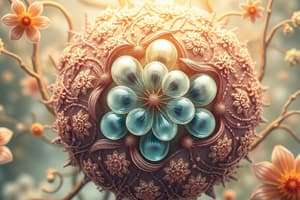Podcast
Questions and Answers
Which of the following are characteristics of life? (Select all that apply)
Which of the following are characteristics of life? (Select all that apply)
- Locomotion (correct)
- Reproduction (correct)
- Invisibility
- Irritability (correct)
What is the basic unit of life?
What is the basic unit of life?
Cell
What type of organism is bacteria classified as?
What type of organism is bacteria classified as?
Prokaryotic
Eukaryotic cells have structures surrounded by membranes.
Eukaryotic cells have structures surrounded by membranes.
What organelle is known as the powerhouse of the cell?
What organelle is known as the powerhouse of the cell?
A plant cell contains a ______ that provides protection and support.
A plant cell contains a ______ that provides protection and support.
Which of the following is a function of lysosomes?
Which of the following is a function of lysosomes?
The largest organelle in a plant cell, responsible for storing water, food, and waste, is called a ______.
The largest organelle in a plant cell, responsible for storing water, food, and waste, is called a ______.
What type of DNA do prokaryotic cells have?
What type of DNA do prokaryotic cells have?
Match the following cell organelles with their primary functions:
Match the following cell organelles with their primary functions:
Flashcards are hidden until you start studying
Study Notes
Characteristics of Life
- Living organisms exhibit locomotion, growth and development, irritability, metabolism and digestion, and reproduction.
Cells: The Basic Unit of Life
- Every living organism is made up of cells, which are fundamental to biological processes.
- A human body contains approximately 100 trillion cells, equivalent to 1 x 10^14 cells.
- There are around 200 different cell types in mammals, each with specific functions.
- Average cell size is about 0.002 cm (20 µm), with roughly 1250 cells fitting shoulder-to-shoulder per inch.
Cellular Diversity
- Prokaryotic cells lack membrane-bound structures and organelles, possess circular DNA, and are mainly unicellular organisms like bacteria.
- Eukaryotic cells have membrane-enclosed organelles and a nucleus, found in plants and animals.
Common Cell Components
- All cells consist of a cell membrane, cytoplasm, and a nucleus, serving as protective and functional units.
Organelles and Their Functions
- Cell Membrane: A protective barrier that regulates what enters and leaves the cell.
- Cytoplasm: The region of the cell outside the nucleus, housing organelles.
- Nucleus: Contains genetic material and controls cellular activities.
- Nuclear Membrane: Protects the nucleus and regulates substance exchange.
- Chromosomes: Structures made of DNA carrying genetic information.
- Nucleolus: Assembles ribosomes within the nucleus.
- Ribosomes: Synthesize proteins essential for cell functions.
- Endoplasmic Reticulum (ER): Involved in protein synthesis, trafficking, and proofreading.
- Lysosomes: Digestive organelles that break down waste, cellular invaders, and recycle components. Absent in plant cells.
- Mitochondria: The energy powerhouse of the cell, generating ATP for cellular activities; involved in aging and muscle-related disorders.
- Chloroplasts: Unique to plant cells, functioning as solar panels for photosynthesis.
Unique Features of Plant Cells
- Cell Wall: Provides structural support and protection, only found in plant cells.
- Vacuole: The largest organelle in plant cells, storing water, nutrients, and waste products.
Cytoskeleton
- A dynamic structure that provides shape to the cell and facilitates movement, akin to a muscular system.
Studying That Suits You
Use AI to generate personalized quizzes and flashcards to suit your learning preferences.




